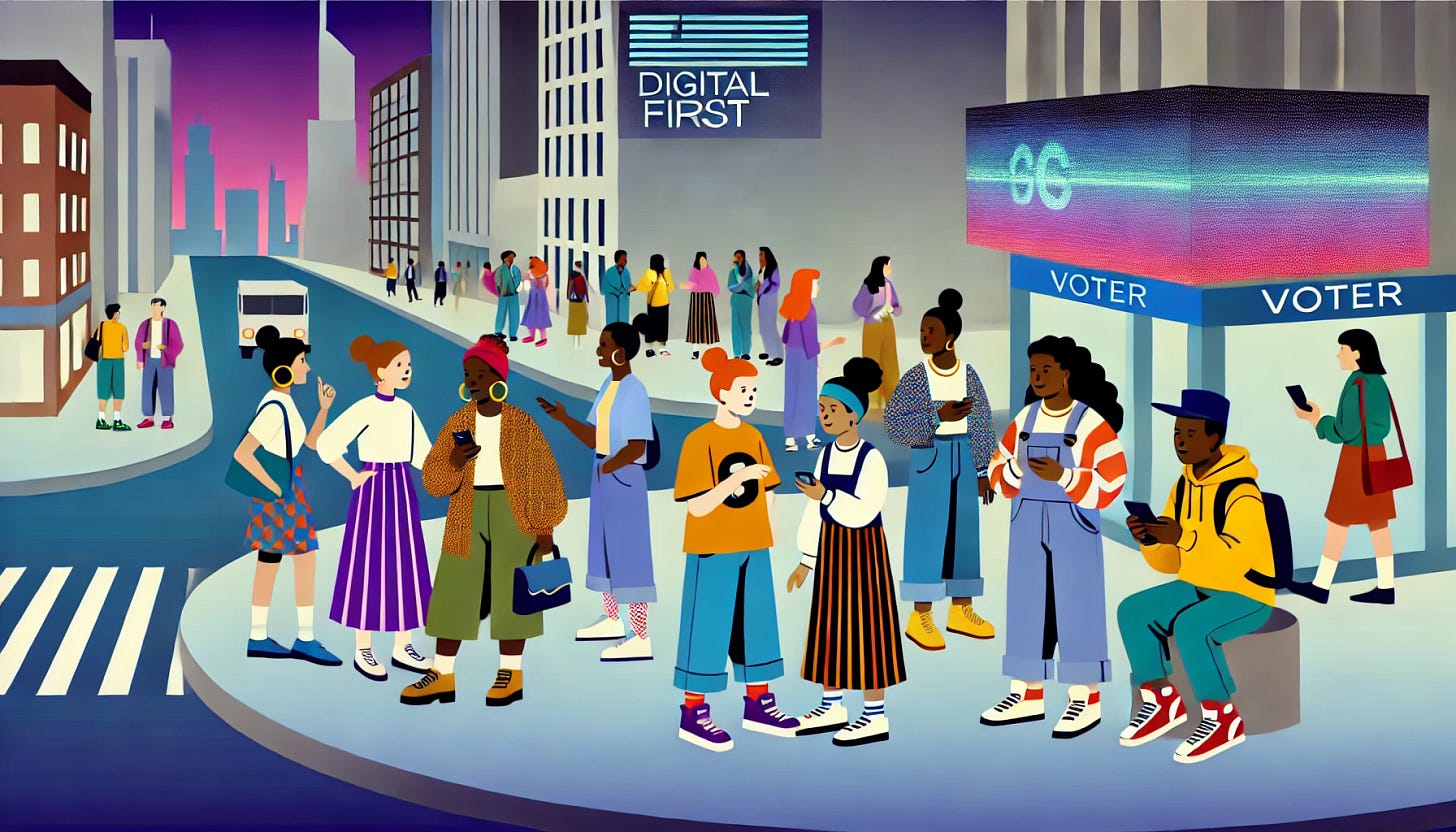PPPPlaybooks for What's Next (Four Ps #246)
Mortaility, "Peopleing," and why EVERY company is an AI company now
Ahh, fall.
A season of vibrant hues of foliage that dazzle the eyes.
But for me, it's the colorful tapestry of people in our lives—each like a brilliant thread in a patchwork quilt—that brings warmth to autumn… a living mosaic, far more beautiful than nature's fleeting brushstrokes.
Fall is the season for connecting—or reconnecting. For revisiting and rewriting our personal and professional playbooks. For finding and forging relationships: coffees, breakfasts, meals, meet-ups, dinner parties, meet-the-teacher nights, sidelines at your kids' sporting events, work conferences, and more.
It's my favorite season for all these reasons.
Already in just the past two weeks, I've met with more than a dozen friends, former colleagues, and even family members I hadn't seen in a long time.
Or something like that.
PERSONAL: Playbook for Aging
During one such breakfast with a friend and former colleague, we spent more of our conversation than expected discussing topics that didn’t come up when we first met 15 years ago: estate planning, caring for elderly parents, aging, and our own mortality.
And I’m glad we did, because these are topics that are often taboo or seen as too depressing for casual conversation. But this is how we learn, adapt, and commiserate. One of the takeaways for me, at her suggestion, was to run out (or more accurately: order on Amazon) and pick up a copy of Being Mortal by one of my favorite authors, Dr. Atul Gawande. Having read three other books by Gawande over the past few years, I was eager to dive in and finished the book cover to cover in just a few days.
No matter how old you are, it’s abundantly clear that this is a topic we need to be more open about discussing and addressing.
The inevitability of death is something we often shy away from, but it’s a conversation we all need to have—both individually and as a society. Advances in medicine are prolonging our lives (on average), but they often extend the period of physical decline, making aging and dying long, drawn-out processes.
This new reality demands a rethink on how we approach the last stop on the train.
As we age, independence starts to slip away—sometimes gracefully, sometimes like a flat tire we hope holds on long enough to get us to the repair shop—leaving us reliant on family, healthcare systems, or whatever social programs haven’t run out of funding yet.
But needing a hand (or a walker) doesn’t mean we should lose our autonomy.
Aging gracefully should still include the essentials: choice, dignity, and purpose—because, let’s face it, just because our knees are quitting doesn’t mean we have to.
Modern medicine, while extending life, often moves dying from the home to hospitals or care facilities. And while these institutions provide care, they often fail to meet the psychological and emotional needs of the elderly. Having recently spent time in a hospital with a family member, I was shocked at how minimal the attention, care, and communication had become.
But it’s not just about prolonging life; it’s about ensuring that life, even in its twilight, still holds meaning.
We must advocate for more compassionate care models, like assisted living or well-designed nursing homes that encourage engagement, purpose, and connection. Facilities that embrace activities like gardening or interactions with children and animals have shown improvements in the emotional and physical health of residents. Because if you’re going to put me in a home in my final years, it better have dogs.
In all seriousness, when we honor people’s independence and sense of purpose, we make the end of life less of a burden and more of a journey to be embraced.
We need to talk openly about aging and death—both with our families and our doctors—so that when the time comes, we can make decisions that honor the lives we’ve lived.
PRACTICAL: Playbook for "Peopleing"
As mentioned, we're out and about. And we're certainly making the most of it!
With a slate of upcoming conferences and networking events (I have a handful coming up—see you there?), I’ve been thinking A LOT about how to make the most of first impressions.
Preparation and planning, even informal, are key to enjoying and thriving in these experiences with people. I call this process "Peopleing."
So trust me when I say: the first few seconds of any interaction can make or break how well your message lands and how far the conversation goes.
Think of it this way: imagine you’re updating your team on a project, but instead of starting with the key info, you dive into details. People might get lost or disengaged. But if you frame your message clearly right from the start—“Here’s the project, here’s what we need to decide today”—you’ll keep everyone on track and focused.
The same principle applies when approaching someone after they step off stage following a presentation at a conference, or when positioning content and messaging priorities on your website. Say it clearly, quickly, and convincingly, and then move on. My approach:
The first pillar of Peopleing—is all about framing: setting the context, sharing your intent, and delivering the key message upfront. It’s a game-changer for getting everyone on the same page.
Once you’ve framed things, I like to use structured summaries to organize my thoughts. Naturally, it’s an acronym: Goal, Problem, Solution (GPS). This helps break down even the most complex topics into bite-sized chunks. Instead of overwhelming your team with too much information at once, you give them exactly what they need to know, when they need it.
When networking, I’m not as formal, but I keep this framework handy for planned (or potentially planned) conversations. Who are they? What do I need to convey? What’s the desired outcome or next step?
Lastly, timing is always important when Peopleing. A quick “Do you have ten minutes to discuss X?” respects the other person’s schedule and ensures they’re ready to engage. “Can I grab you for 30 seconds?” works for even briefer interactions. Throw in a quick validation checkpoint during the conversation to make sure you’re still aligned, and you’ll have a much more productive chat.
Whether it’s an email, meeting, or quick message, if you master framing, structured summaries, and timing, you’ll improve your communication—and your reputation as a clear, efficient professional. Every word counts, so make Peopleing work for you!
PROFESSIONAL: Playbook for A.I.
Are you an AI company? Am I?
What is an AI company, anyway?
To be clear, no, not every company is truly an AI company, even though many are eager to claim the title. And this has become a fascinating, must-watch development across the marketing ecosystem.
The real distinction comes down to whether a company is building proprietary AI solutions or simply using existing tools like ChatGPT. Companies that develop AI technologies from scratch, such as enterprise-grade hardware and software, are clearly at the forefront of the AI industry.
On the other hand, those integrating AI into their customer-facing products, internal operations, or leveraging external AI tools may use AI but can’t necessarily claim to be full-fledged AI companies. They might be AI-powered, but calling themselves AI companies can be a stretch. And then there are just weird examples, like this avocado-peeling robot.
Spoiler: just slapping AI onto your pitch deck doesn’t make you an AI company. In this brave new world, integrity and innovation are the real currency.
The government has already been in the mix, albeit inconsistently! Until now. Senator Edward J. Markey’s new Artificial Intelligence Civil Rights Act might just make sure that those who claim to be don’t take unfair shortcuts. Markey’s legislation, introduced last week, aims to put crucial guardrails around the use of AI algorithms, particularly in high-stakes areas like employment, banking, healthcare, and criminal justice.
It addresses a growing concern: while AI can streamline processes and open doors to innovation, it also has a dark side—it can deepen inequities, enhance discrimination, and infringe on civil rights. This Act would demand independent audits both before and after AI is deployed, focusing on biases that could impact people’s lives. With the Federal Trade Commission standing by to enforce these new rules, companies that aren’t taking AI accountability seriously might be in for a rude awakening.
The rush to associate with AI has led to a phenomenon known as "AI washing," where businesses exaggerate their AI capabilities to keep up with the hype. This practice carries risks, including loss of trust and legal consequences. The SEC has also taken action against companies making false AI claims, warning that such misrepresentation could lead to legal penalties. The key takeaway? Companies need to be realistic and transparent about their AI capabilities, or they may face serious repercussions.
Whoever has the final say, companies can no longer coast on AI buzzwords without the substance to back them up.
It’s a wake-up call for businesses claiming to be AI-driven without actually innovating. As the world scrambles to regulate AI, it’s more important than ever to know where you stand and what you say.
PODCAST: Playbook for Creativity
Tired of traditional agencies failing to deliver results? In this episode of The Snarketing Podcast presented by Leadfeeder, we explore the revolutionary agency model shaking up the marketing world with X&O co-founders, Eric Segal and Brett Banker.
They share how they’ve built an agency that combines consultancy and creative execution, delivering impactful ideas faster and more affordably.
Listen as Eric and Brett reveal their secrets for winning pitches with micro CVs, the value of charging for creative work, and why flexibility is key in today’s chaotic marketing landscape. Learn why CMOs turn to X&O for urgent brand strategy challenges.
POLITICAL: Playbook for the Election
The lead-up to the 2024 presidential election, which is FIVE WEEKS FROM TODAY(!) is a textbook study in how campaigns are adapting to the evolving preferences of key demographic groups—male voters, Gen Z, and young women — all of whom are reshaping the political landscape in different ways.
Man (and woman), do I wish I was still in college studying this election in the same way I was entrenched with the brilliant comms and poli sci professors during the 2000 election.
Let's look at a few themes:
"Bro Culture" & Male Voters: The Harris campaign is actively pursuing male voters, particularly white men, who are often caught in the crossfire of MAGA rhetoric. Through initiatives like the “White Dudes for Harris” campaign, Harris is trying to carve out a space for those men who feel sidelined by extreme right-wing politics. I've been on a few of these types of calls, and the energy is real. And the white male minority (at least amongst her voting bloc) is fired up.
The Harris-Walz strategy here has been masterful: focus on authentic masculinity (hello, Harvester Scout!), meant to resonate with men by speaking their language—not lecturing or pandering.
White men get a bad rap, most of it deserved, especially when the crowds at rallies for Trump and his “MAGA buddies” look like the basement of a Fiji frat party at Penn back in 1999 (where Don Jr. lived at the time), all of them shouting nonsense in their stupid red hats and acting like they speak for us when they don’t.
Swing states like Michigan and Wisconsin make this an especially crucial play. And for the first time ever, I even considered buying a camo hat.
The Rise of Liberal Young Women: Since 2016, the political trajectory of young women has leaned sharply left. Motivated by gender equality, reproductive rights, and broader societal concerns, more than 40% of young women now identify as liberal. Not just centrist or mainstream, but liberal.
This ideological shift is powerful and personal, driven by events like the 2016 election and the overturning of Roe v. Wade, sparking a sense of activism among many.
And no, it doesn't hurt that a younger female candidate of color is atop the ticket. Just saying...
Gen Z’s Digital News Revolution: Gen Z has the power to swing this election unlike any other, and for many, it will be their first time voting. This is a digital-first generation, and apps like TikTok and Instagram acting as their go-to news sources.
Pew Research reveals a 23% jump from 2020 in TikTok’s use for news among young adults. This shift reflects both a mistrust of traditional media and the convenience of quick, viral news consumption. Campaigns face a tough balancing act—winning over Gen Z on these platforms without feeling outdated or inauthentic.
Ultimately, with weeks to go, the 2024 election promises to be a battleground shaped by a more diverse, tech-savvy, and ideologically fragmented electorate. Campaigns must harness cultural relevance and emotional appeal, and perhaps even a little bit of AI-powered fun, to capture the hearts, minds, and votes of these key voter groups.
PROVOCATIONS: Things I Read And Like
For Prophets:
Amazon's AI ad creator: Still just ads, not at all a community (Amazon)
Snapchat’s My Selfie puts users' faces on personalized ads (DTC Media)
For Pessimists
It's not just TikTok. U.S. cracking down on Shein and Temu (Fortune)
YouTube still rules with GenZ (Ad Age)
For Pioneers
Q&A in Marketing Brew with Michael Miraflor - who I miss since quitting Twitter (MarketingBrew)
Alternative Four Ps: Perspective. Perception. Pioneering. Persistent (Rishad Tobaccowala)
For Parents:
Reading is no longer fundamental (ABC News)
See (some of) you in Las Vegas at GroceryShop and back in New York City for Advertising Week NY!








